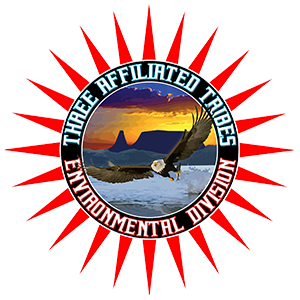U.S. GEOLOGICAL SURVEY
Project Description-Water Quality Assessment of the Fort Berthold Reservation in North Dakota 2014-2019
PURPOSE AND SCOPE
The primary purpose of this proposed project with USGS is to continue to make progress to establish an ambient water-quality sampling program to monitor groundwater and surface water resources on the Fort Berthold Reservation. At full operational capacity, this program will annually include:
-
Samples collected from 20 groundwater wells
-
Samples collected from the 6 major drainages that flow into Lake Sakakawea
-
Operation of stream flow gaging stations at the 6 major drainages
All samples will be analyzed at the EPA under Methods: 8260, 8270, Ammonia as N, Anions by cap IC, DRO, DOC, GRO, Hardness, ICP-Dissolved Metals, ICP-MS dissolved metals, ICP-MS total metals, TOC-TN and field parameters (pH, specific conductance, water temperature, turbidity, and dissolved oxygen).
2016 APPROACH
Objective 1 – Groundwater-Quality Sampling continued
The overall objective is to identify a population of wells that:
-
Represent all aquifer systems used
-
Have good spatial coverage of the FBIR
In 2014, the proposed project was initiated and 11 groundwater wells were sampled. The majority of these wells are located on the east side of FBIR. Many factors contributed to the lack of samples on the west side including: inability to locate, access denial, lack of driller’s logs, construction and piping issues.
In 2015, nine groundwater wells were sampled.
In 2016, the objective is to identify and sample wells (10-15) on the west side of FBIR with particular focus on the Mandaree and Shell Creek Segments. These segments are where most tribal members live and is experiencing a significant amount of energy production. We have identified 25 wells that meet the criteria.
The initial phase will require identifying wells that fit the sampling criteria and obtain permission from well owners. Wells chosen could include: private wells (drinking and/or livestock), observation, industrial supply, or public supply.
The reconnaissance and sample collection will be conducted by and coordinated between personnel from TAT Environmental Division, USGS and EPA. Reconnaissance will take place May-July. Groundwater sampling will occur once proper wells are located, likely in July, August, and October..
Objective 2 – Surface Water-Quality Sampling continued
Six major drainages flow into Lake Sakakawea: East Fork Shell Creek, Deepwater Creek, Shell Creek, Squaw Creek, and Moccasin Creek. In 2014, these six drainages were sampled twice. In 2015, samples were collected four times. To continue to monitor changes in water-quality in streams over the range of hydrologic conditions on the Fort Berthold Reservation, these six locations will be sampled 4 times a year. Samples in 2016 will be collected in April, June, August and October.
Water-quality samples will be collected using the equal-width-increment (EWI) method. If stream velocities are less than 1.5 cubic feet per second, a grab sample will be collected from the center of the stream channel. Samples collected with either method will be composited into a churn splitter and samples are processed from the churn splitter. Streamflow will be measured each time a water-quality sample is collected.
Objective 3 – Streamflow Gaging Stations
Five of the major drainages being sampled as part of this proposal do not have a streamflow gage. Bear Den Creek is the only drainage being monitored. Due to the cost to install the other 5 monitoring stations, installation should be triaged. It is proposed that the East Fork Shell Creek gaging station be installed this year given its proximity to the PWS intake and the increased energy extraction activities to the drainage.
Streamflow gages will include continuous, real-time stage and streamflow information. To develop the relation between stage and streamflow, discharge measurements will be made periodically throughout the year over the range in hydrologic conditions. To reduce cost, gages will be operated on a seasonal basis. Operation will be approximately from March through November, when open water conditions occur.
RELEVANCE AND BENEFITS
Information provided by this project will assist water resource managers for the TAT in managing water resources on the Reservation, particularly related to the recent rapid development of energy resources in the area, and associated potential risks to water resources within the Reservation.
PRODUCTS
Water Quality data will be managed and compiled by USGS and TAT personnel. The data will be entered into the USEPA Ambient Water Quality Monitoring System (AQWMS) database by TAT personnel with USGS assistance. Additional meetings and presentations will be conducted to discuss the project and results with TAT, tribal members and the public as requested. Announcements of USGS publications to the public will be made through press releases and web postings. Also, data will be made available from the USGS NWIS database from the USGS website. Click to view the 2014-2019 QAPP (Quality Assurance Project Plan) . Click to view the 2016 QAPP Revisions.
|
